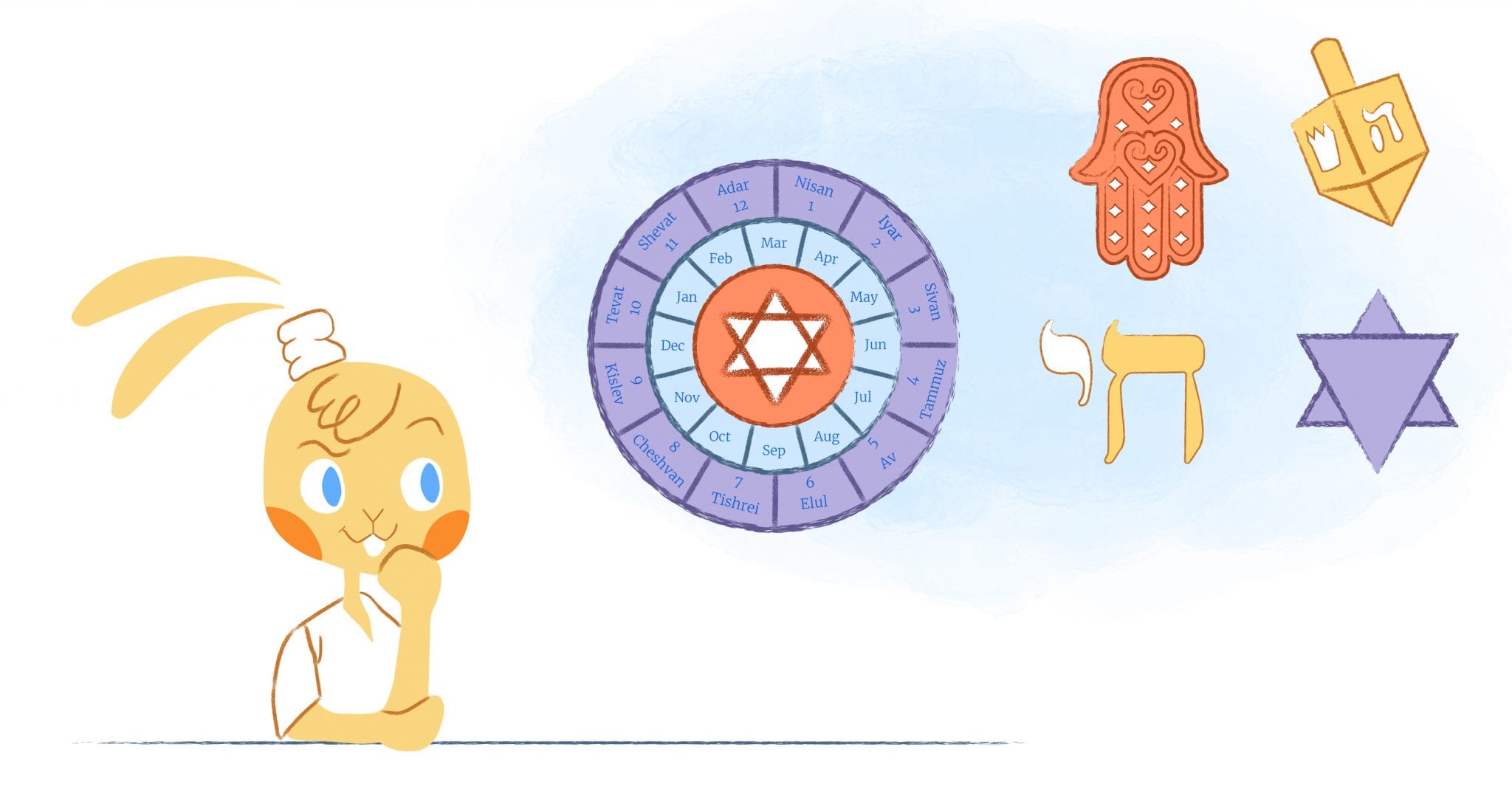

It’s not uncommon for calendars, both those used in ancient civilizations to the online calendars we use today, to be based on the Earth’s revolution around the sun. But, other observable phenomena, such as the phases of the moon, have also been used. One long-lasting example of the calendar is the Hebrew Calendar.
What’s fascinating about this solar/lunar calendar is that it’s been used for centuries and is significantly steeped in scripture. That makes it one of the most unique and complex calendars ever created. And, it still plays a vital role for millions of people around the world today.
If you’re unfamiliar with the Hebrew calendar, then you’ve come to the right spot. Here is an introduction to the Jewish calendar with 12 calendar facts you should know.
1. Sun, moon, and holy scripture.
The Jewish calendar is lunisolar, just like the Ancient Macedonian, Babylonian, Egyptian, and Chinese calendars. Corresponding with all of the lunisolar calendars means that the Jewish calendar is in sync with the natural cycles of the moon and the sun. These astronomical phenomena helped determine the length of a day, month, and year. For example, days are set by the rotation of the Earth’s axis. Months are determined by the revolution of the moon around the Earth, roughly 29 ½ days. And years, which are around 365 ¼ days, are how long it takes for our planet to rotate around the sun.
What’s unique about the Hebrew calendar, however, is that it also contains “a body of complex regulations, exceptions, and mathematical rules,” states Time and Date. The calendar “is also designed to satisfy many requirements conveyed in the Jewish Holy Scripture.”
It should also be noted that the Hebrew calendar is also a comparatively “imprecise system in terms of reflecting the duration of a solar year.” The reason is that the “time it takes Earth to complete a full orbit around the sun,” when compared “with the timing of the astronomical seasons,” is off by one day every 216 years.
2. Three periods of history.
The history of the Jewish Calendar, according to Bible History Online, is divided into the following three periods:
- Biblical — it was during this period, which was between Abraham’s call to enter Canaan and Jacobs entry into Egypt, that “the understanding of the Calendar was based entirely upon the observation of the sun and the moon.”
- Talmudic — this period, which occurred around 500 BCE, “rested upon observation and reckoning.”
- Post-Talmudic — this period, which took place from about 690 BCE to the 11th Century, “rested entirely upon reckoning.”
“The Hebrews studied astronomy very carefully because of their intense need for accurate dates in keeping the festivals.” For instance, in Deuteronomy 16:1, the Lord said: “keep the month of Aviv.” Because of this, it was necessary for Hebrews “to become very acquainted with the position of the sun.”
There was also the command to “observe the moon and sanctify it.” The command was the reason why the Hebrews studied the phases of the moon so intensely.
3. Background of the Jewish calendar.
In the Old Testament, written in the Book of Exodus, that the Jewish have used a lunisolar calendar ever since they departed Egypt. It’s believed that “the first commandment the Jewish people received as a nation was to determine the New Moon,” notes Hebrew Calendar Facts for Kids. “Very soon after that, the Jews received the commandment to make sure that Passover falls in the spring.”
Both the Israelites and the Babylonians heavily influenced the creation of the calendar. But, it was between 70 and 1178 BCE that the ancient observation-based calendar was replaced with one that was more calculated by mathematics. The month names of the modern Hebrew calendar were derived from the Babylonian calendar dating back to the 6th Century BC during the Babylonian exile.
The Jewish calendar was mainly used to establish dates for holidays were the corresponding portions of the Torah were read to the public. But, following the destruction of the Second Temple in 70 CE, it wasn’t as easy for people to meet and listen to these passages. As a result, “the Sanhedrin established a fixed, rule-based form of the calendar. Maimonides fully described the modern Hebrew calendar around the year 1178 CE.
However, Persian astronomer al-Khwarizmi (c. 780 – 850 CE), claimed that the features of the modern-day version were created in the 9th century CE.
Also, in the modern Hebrew calendar, years are counted as Anno Mundi. Anno Mundi is Latin for “year of the world” and represents the traditional count of years since the creation of the world — as described in Genesis.
4. When was the year one?
According to Hebrew time reckoning, we are currently in the sixth millennium. The Hebrew year count starts in the year 3761 BCE (before common era). The practice was implemented in the 12th-century when the Jewish philosopher Maimonides established the timeframe as the biblical date of Creation.
According to Time and Date, “Years in the Jewish calendar are designated AM to identify them as part of the Anno Mundi epoch.” The Anno Mundi epoch indicates “the age of the world, according to the Bible. For example, the beginning of the year 2018 in the Gregorian calendar converts to year AM 5778 in the Jewish calendar.”
5. Days of the Jewish Week.
Rabbis determined that the start of a new day begins precisely when the sun goes below the horizon, meaning, at sunset. A new day starting at sunset makes sense — but it’s the opposite of our secular day reconning. In the Gregorian calendar, when the sun comes up in the morning, we think it’s the start of a fresh calendar day — even though we count the new day from one second after midnight. Beginning a celebration just as the sun goes below the horizon further explains why every Jewish holiday begins the evening before the first day of it being observed.
Referencing the Hebrew Calendar Facts for Kids, the tradition of the sunset is ignored by those who print calendars and those who write calendar programs for computers. “They treat the Hebrew calendar date and the Gregorian calendar date that has the same midnight — as being the same day.” What’s more, they “assume that people reading a Hebrew calendar know the sundown rule. Whenever a holiday, birthday, or anniversary appears on a printed calendar — it actually begins on the day before, at sundown.”
These are important distinctions to remember. What’s interesting is besides Shabbat — which is the name of the seventh day of the week — there are no names for the days of the week in the Jewish calendar. The days of the week are known as the first day, second day, the third day, and so forth. There are times when the days of the week are referred to as the First Day of the Sabbath.
6. Months of the Jewish Year.
Originally, numerals were put in place to distinguish one month from another. Aviv, the month that marks the beginning of spring, is the first month. The following months are referred to as the second month, the third month, and so forth. The Bible mentions the names of many of the other months besides Aviv. The second month is named Ziv (1 Kings 6:1); Etanim, is the seventh month (1 Kings 8:2); and the eight-month is known as Bul ( 1 Kings 6:38).
The months of the Jewish calendar are as follows:
- Nisan: It contains 30 days and occurs around March-April.
- Iyar: Takes places in April-May and has 29 days.
- Sivan: This 30-day month is the Gregorian equivalent to May-June.
- Tammuz: A 29-day month around June-July.
- Av: Occurs July-August and has 30 days.
- Elul: Contains 29 days and is the equivalent to August-September.
- Tishri: A 30-day month during September-October.
- Kheshvan (Cheshvan): Either 29 or 30 days in October-November.
- Kislev: Another 29 or 30-day month taking place around November-December.
- Tevet: This month has 29-days around December-January.
- Shevat: Features 30 days during January-February.
- Adar: This is the equivalent to February-March and has 29-days. However, in a leap year there 30.
- Adar II: The second month of Adar is sometimes added during leap years and has 29-days.
7. The numbering of Jewish Years.
The number of the year found on the Jewish calendar is the traditional date of creation. The period can be calculated by adding up the genealogies found in the Tanakh. Using the calculation doesn’t necessarily mean that the universe has been in existence for merely 5700 years. For example, it’s not uncommon for Orthodox Jews to consider the first six “days” of creation as not the 24-hour days that we’re currently used to.
Additionally, “A.D.” (anno domini, “in the year of our Lord” and “B.C.” (before Christ) are not used. The reason is that in Judaism, Jesus is not considered the Lord. Instead, the abbreviations C.E. (Common Era or Christian Era) and B.C.E. (Before the Common Era), are correct.
Explained in ReligionFacts, “Determining what marks the Jewish New Year is a bit complicated.” As we know, Nisan is thought of as the first month of the year. “However, the year number changes on Rosh Hashanah, which is on the first of Tishrei, the seventh month of the religious year. Then there is Tu B’Shvat (15 Shvat), which is the new year ‘for trees.’”
That information may sound confusing. The easiest way to understand this knowledge is understanding that the Jewish calendar has different “years” that serve specific purposes. These purposes contain data “just as the secular world recognizes time passage in a fiscal year, a school year and a calendar year.” So, here’s the bottom line: Nisan is the first month on the Jewish calendar, while Rosh Hashanah (on one Tishrei) celebrates the “Jewish New Year.”
8. 19-year cycles.
Remember Adar II? Adar II came to be after the Israelites in ancient times had to account for the imperfections of the lunar calendar. To correct the inaccuracies, they came up with 19-year cycles that a month every third, sixth, eighth eleventh, and nineteenth years of the cycle. Considering the cycle is how we account for Adar II. The corrected accounting also helped establish the number of days in each month.
9. There are Four Jewish New Year’s celebrations.
We skimmed over this previously. But, traditionally, the Jewish calendar has four different days that are dedicated to the new year. Each serves a different purpose. Again, we celebrate the New Year on January 1. But, the new year for schools begins in September, and fiscal and budget years start in October.
Hopefully, this solves any confusion you may have. And, with that out of the way, here are what each “new year” represents.
- Nisan: This occurs in the Spring, usually around April, and marks the beginning of a new Biblical year.
- Elul: This was the new year for animal tithes and takes place in the sixth month of the calendar, around August.
- Tishri 1: Also known as Rosh Hashanah, this new year occurs on the first day of the seventh month, usually in September. Its date is known as when the world was created.
- Shevat 15: Falling between January and February, Shevat or Tu B’Shvat, marks the date calculating the titles for harvest.
10. The molad.
As you know, the Hebrew calendar is lunar-based. That means the calendar needs to calculate how long it takes for the moon to orbit the Earth. In the Jewish calendar, each new month begins with the molad, which means “birth” in Hebrew. It took years to calculate the length of the cycle from one new moon to the next, which is 29 days, 12 hours, 44 minutes, 31⁄3 seconds.
Or, the average time from molad to molad would be 29 days, 12 hours, and 793 chalakim. If you’d like to know, there are 1,080 chalakim or “parts” in an hour, so a chelek is 3.33 seconds)
11. Calculating the calendar.
As just discussed, the length of a molad is slightly more than 291⁄2 days. But, because a month must have a whole number of days, you need to do some math to calculate the Hebrew calendar.
It starts with alternating months of 30 and 29 days, which comes out to a calendar consisting of 12 months and 354 days. Of course, there are 365 days in a year; hence, math has to get involved.
I’m hoping my math is not off. The Hebrew Calendar is so exciting and exciting. Tracey R. Rich explains how to calculate the calendar in great detail if you want to have a closer look.
Here’s a necessary explanation from our friends at Hebrew Calendar for Kids.
Start with an average of 291⁄2 days and a 12-month total of 354 days. Keep in mind that when an extra month is added, “it is month six (counting from Tishrei), and always has 30 days.”
- “When the number of days between this Rosh Hashanah and next is 355 days in a regular year (or 385 days in a leap year), an extra day is needed. It is added to Heshvan (month two counting from Tishrei), which then has 30 days.
- When the number of days between this Rosh Hashanah and next is 353 days in a regular year (or 383 days in a leap year), one fewer day is needed. It is taken away from Kislev (month three counting from Tishrei), which then has 29 days.”
12. Is the Hebrew calendar still used today?
Yes, the Hebrew Calendar is still in use today. It’s used for Jewish religious observances, and this calendar is the official calendar of Israel. As Elon Gilad writes in Haaretz.com, “Under the law, official Israeli documents must have the Hebrew date on them. Moreover, holidays in Israel are determined according to the Jewish calendar, not the Gregorian one.”
What happens here is that holidays, such as Rosh Hashanah, “will happen on the same date each year according to Jewish reckoning — but on a different day each year according to the Gregorian calendar.” Once you get used to the Hebrew or Jewish Calendar, you can see how accurate it is, but the “Gregorian and Jewish calendars don’t coincide.”











Deanna Ritchie
Editor-in-Chief at Calendar. Former Editor-in-Chief, ReadWrite, Editor-in-Chief and writer at Startup Grind. Freelance editor at Entrepreneur.com. Deanna loves to help build startups, and guide them to discover the business value of their online content and social media marketing.